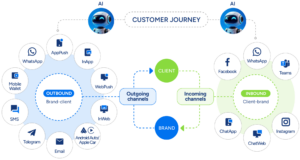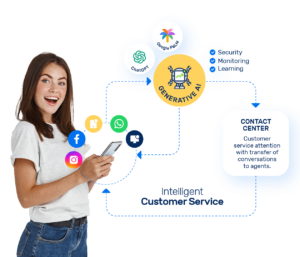
Digital Customer Engagement: What You Need to Know
Overview
- Digital Customer Journey: Optimize Every Touchpoint for a Satisfying Experience
- Not sure if you’re connecting with your customers? Measure customer engagement.
- Not reaching your audience? Maybe you’re not using the right distribution channels for your service.
- Inefficient Processes Are Costing You Money, Solve It with Generative AI for Sales
- Hit Them Where It Hurts: Learn What a Pain Point Is in Marketing
Today, mastering digital customer engagement across online channels is crucial for business success. This comprehensive guide will explore the fundamentals of digital customer engagement, its importance, key strategies, and best practices to help your business thrive in the digital landscape.
What is Digital Customer Engagement?
 Digital customer engagement refers to the interactions between a business and its customers through various digital channels, aimed at building lasting relationships, enhancing customer satisfaction, and driving loyalty. This engagement encompasses a wide range of activities, including personalized email communications, social media interactions, live chat support, and participation in online communities. As consumers increasingly rely on digital platforms for their interactions, businesses must adapt by leveraging technologies such as AI and data analytics to provide seamless, personalized experiences. Effective digital customer engagement not only fosters stronger connections with customers but also significantly influences brand loyalty and overall business success
Digital customer engagement refers to the interactions between a business and its customers through various digital channels, aimed at building lasting relationships, enhancing customer satisfaction, and driving loyalty. This engagement encompasses a wide range of activities, including personalized email communications, social media interactions, live chat support, and participation in online communities. As consumers increasingly rely on digital platforms for their interactions, businesses must adapt by leveraging technologies such as AI and data analytics to provide seamless, personalized experiences. Effective digital customer engagement not only fosters stronger connections with customers but also significantly influences brand loyalty and overall business success
Difference Between Traditional and Digital Engagement
The core difference between traditional customer engagement and digital customer engagement is of course where the interactions take place. Traditional customer engagement focuses on in-person interactions, phone conversations, and physical mail, while digital engagement leverages online channels. Here are some key differences:
- Reach: Digital engagement offers global reach and 24/7 accessibility, whereas traditional methods are often limited to local or regional audiences.
- Personalization: Digital engagement allows for automated, data-driven personalization, while traditional methods rely more on manual, personal interactions.
- Cost-efficiency: Digital engagement is generally more cost-effective and scalable compared to traditional methods, which often require higher investments in infrastructure and staffing.
- Feedback loop: Digital engagement provides instant feedback through online reviews and comments, enabling faster response times compared to traditional methods.
As in-store experiences frequently include digital touchpoints such as POS systems and loyalty programs, modern customer engagement often requires a hybrid approach.
Why Digital Customer Engagement Matters
The evolution of customer interactions reflects a shift from traditional face-to-face encounters to AI-driven solutions. This transformation has been driven by:
- Social media emergence: The rise of social media in the early 2000s allowed businesses to engage directly with customers, fostering transparency and community building.
- Data-driven insights: The digital age brought access to vast amounts of customer data, enabling businesses to better understand consumer preferences and tailor their approaches.
- Technological advancements: Chatbots, mobile apps, and AI-powered solutions have revolutionized how businesses interact with customers, providing instant, round-the-clock support.
- Emphasis on authenticity: While technology has enhanced efficiency, the human element remains crucial. Customers value brands that demonstrate empathy and social responsibility.
Today digital customer engagement has become more crucial than ever as in-store shopping continues to decrease. Here are what’s driving that trend:
- Changing consumer behavior: With the proliferation of smartphones and social media, customers expect seamless, personalized experiences across digital channels.
- Increased visibility: Digital engagement offers greater exposure and reach compared to traditional marketing channels, allowing businesses to connect with their target audience more effectively.
- Data-driven insights: Digital engagement provides valuable customer data and analytics, enabling businesses to refine their strategies and improve overall customer experience.
- Cost-effectiveness: Digital engagement often yields a higher return on investment compared to traditional methods, making it an attractive option for businesses of all sizes.
- Competitive advantage: Companies that excel in digital customer engagement can differentiate themselves in the market, leading to increased customer loyalty and revenue growth.
By embracing digital customer engagement, businesses can create more meaningful connections with their audience, adapt to changing market dynamics, and drive long-term success in an increasingly digital world.

What digital channels are there?
Digital channels today come with a wide variety of distribution methods, but some standout as most often used by marketers and brands today:
1. Website
Your website is the foundation of most businesses. it is the first place people visit and the most often place people return to. you should treat it like a product, maintain and optimize it regularly. Websites are also jumping on points for many other types of digital communications such as web push notifications, email, sms, and chat bots. Landing pages and web experience can make or break a business so treat them with care.
2. Email
Email was one of the first types of digital communications. It is a medium that is regularly used by marketers but also has become congested and creates less and less impact on consumers year over year. It is still an extremely important channel for communicating with your customers, but treat these types of communications with less urgency or utilize them transactionally with things like order purchases where referring back to a communication may be important to consumers in the future.
3. Social Media
Social media has become one of the most important channels as well, and if you’re not sensing a theme just yet the fact of the matter is that all channels are now important. User preferences for communication channels have become disparate and Scattered. and optimizing Channel mix for each individual user’s preference has become essential for businesses. Social media presence in particular is one that is often utilized for more general communications things like sales where there might be some urgency. but they rely upon users actively using other apps to make the greatest impact. Unlike email many folks don’t receive notifications for the brands they follow. However, social media is one of the most engaging forms of digital Communications today. is one where you can create deep and meaningful experiences for consumers which have lasting impacts which is why it’s still a channel that brands must focus on to be successful.
4. Mobile Apps
Depending on your industry, mobile applications have become a core standard. Giving users a dedicated platform to interact with your brand can significantly enhance customer experience and loyalty. Mobile apps allow for personalized experiences, push notifications, and seamless integration with other services. They are particularly effective for businesses that require frequent user interaction, such as e-commerce, fitness, or banking. However, developing and maintaining a mobile app requires significant investment, so ensure it aligns with your business goals and user needs.
5. SMS
SMS (Short Message Service) is a highly effective communication channel due to its immediacy and high open rates. Unlike email, SMS messages are typically read within minutes of being received, making it an excellent tool for time-sensitive communications like appointment reminders, order confirmations, or flash sales. However, because SMS is a more intrusive form of communication, it’s important to use it sparingly and ensure that the content is relevant and valuable to the recipient. Overuse can lead to opt-outs and a negative brand perception.
6. Chatbots
Chatbots have revolutionized customer service and engagement by providing instant, automated responses to user inquiries. They can be integrated into websites, mobile apps, and social media platforms, offering 24/7 support and streamlining interactions. Chatbots are particularly useful for handling frequently asked questions, guiding users through processes, or even facilitating transactions. However, to be effective, chatbots must be well-designed, conversational, and capable of handling complex queries or escalating issues to human agents when necessary. When implemented correctly, chatbots can significantly enhance user experience and reduce operational costs.
By leveraging these digital communication channels effectively, businesses can create a cohesive and engaging experience for their customers, ensuring they stay connected and satisfied across all touchpoints.
Multi-Channel vs Omnichannel Digital Customer Engagement
While both multi-channel and omnichannel approaches involve engaging customers across multiple platforms, there are key differences in their implementation and customer experience.
Multi-Channel Engagement
Multi-channel engagement involves interacting with customers through various channels, such as social media, email, website, and mobile apps. Each channel typically operates independently, with its own strategy and goals. The main characteristics of multi-channel engagement include:
- Separate channels with distinct strategies
- Limited integration between channels
- Potential for inconsistent messaging across platforms
- Focus on maximizing the effectiveness of individual channels
For example, a company might have a social media team managing Facebook and Instagram, while a separate team handles email marketing. These teams may not necessarily coordinate their efforts or share customer data.
Omnichannel Engagement
Omnichannel engagement takes multi-channel a step further by creating a seamless, integrated experience across all channels. Key features of omnichannel engagement include:
- Unified customer view across all touchpoints
- Consistent messaging and branding across channels
- Seamless transitions between channels
- Data sharing and integration between platforms
In an omnichannel messaging approach, a customer might start a conversation on social media, continue it via email, and complete a purchase in-store, with all interactions recorded and accessible across channels.

Key Differences
Aspect | Multi-Channel | Omnichannel |
Integration | Limited | Comprehensive |
Customer Experience | Potentially fragmented | Seamless and consistent |
Data Sharing | Minimal | Extensive |
Strategy | Channel-specific | Holistic, customer-centric |
Benefits of Omnichannel Engagement
While multi-channel engagement can be effective, omnichannel engagement often provides superior results:
Improved customer satisfaction due to consistent experiences
Higher customer retention rates
Increased sales and conversion rates
Better insights into customer behavior and preferences
Implementing an omnichannel strategy requires more investment in technology and coordination between teams, but it can lead to significantly better outcomes in customer engagement and loyalty.
Best Practices for Digital Customer Engagement
Digital customer engagement has become a cornerstone of modern business success. By implementing effective strategies, companies can build stronger relationships with their customers, enhance loyalty, and drive growth. Here are the best practices for digital customer engagement:
Know Your Audience
Understanding your customers is fundamental to effective engagement. Develop detailed customer personas to gain insights into their preferences, pain points, and preferred communication channels. This knowledge allows you to tailor your engagement strategies to meet their specific needs and expectations.
Develop an Omnichannel Presence
Provide a seamless, consistent experience across all digital touchpoints. This approach allows customers to easily switch between platforms without losing context. Key elements of an omnichannel strategy include:
- Unified customer profiles across channels
- Consistent messaging and branding
- Ability to continue conversations across different touchpoints
Personalize the Customer Experience
Leverage customer data to create tailored interactions based on individual preferences and behaviors. Personalization can significantly enhance engagement and may include:
- Product recommendations
- Customized content and offers
- Location-based services
Leverage AI-Powered Chatbots
Implement interactive chatbots to provide instant, 24/7 customer assistance. These AI-powered tools can handle routine inquiries, freeing up human agents for more complex issues. Benefits of chatbots include:
- Faster response times
- Reduced support costs
- Improved customer satisfaction
Gather and Act on Customer Feedback
Regularly collect feedback through surveys, reviews, and social listening. Use these insights to:
- Identify areas for improvement
- Measure customer satisfaction
- Inform future engagement strategies
Implement Proactive Communication
Reach out to customers with relevant, timely information before they need to contact you. This proactive approach may involve:
- Order status updates
- Appointment reminders
- Product usage tips
- Exclusive offers
Engage on Social Media
Utilize social platforms to interact with customers in real-time, share updates, and gather feedback. Best practices for social media engagement include:
- Responding promptly to inquiries and comments
- Sharing valuable, shareable content
- Running contests and promotions
- Showcasing user-generated content
Provide Value in Every Interaction
Ensure that each touchpoint offers something useful or meaningful to the customer. This approach helps build trust and encourages continued engagement.
Be Responsive and Timely
Aim to respond to inquiries and comments as quickly as possible across all channels. Prompt responses demonstrate that you value your customers’ time and concerns.
Maintain a Consistent Brand Voice
Develop guidelines to ensure messaging is cohesive across all digital touchpoints. A consistent brand voice helps build recognition and trust among your audience.
Embrace Video Content
Incorporate video into your engagement strategy for higher impact and engagement rates. Video content can be particularly effective for product demonstrations, tutorials, and customer testimonials.
Prioritize Mobile Experiences
Ensure all digital touchpoints are optimized for mobile devices. With the increasing prevalence of mobile usage, providing a seamless mobile experience is crucial for effective engagement.
Test and Iterate
Continuously experiment with new engagement tactics and refine your approach based on results. This iterative process allows you to stay agile and adapt to changing customer preferences and market conditions.
Analyze Customer Data Continuously
Leverage analytics to uncover trends, optimize processes, and refine engagement strategies. Key metrics to track include:
- Customer satisfaction scores
- Engagement rates across channels
- Conversion rates
- Customer lifetime value
By implementing these best practices, businesses can create a robust digital customer engagement strategy that fosters loyalty, drives growth, and provides a competitive edge in today’s digital-first marketplace. Remember that effective engagement is an ongoing process that requires continuous learning, adaptation, and optimization to meet evolving customer expectations and technological advancements.
Measuring Digital Customer Engagement Success
To gauge the effectiveness of your digital engagement efforts, track these key metrics:
- Customer satisfaction score (CSAT)
- Net Promoter Score (NPS)
- Customer retention rate
- Customer lifetime value (CLV)
- Engagement rates across channels (e.g., email open rates, social media interactions)
- Conversion rates
- Average response time
- First contact resolution rate
Regularly analyze these metrics to identify trends and areas for improvement.
Overcoming the challenges of digital customer engagement
Understanding Customer Needs and Preferences
One of the biggest obstacles in digital engagement is truly understanding what customers want and need. Without this insight, efforts to connect often miss the mark.
To address this:
- Implement robust data collection and analytics to gain a 360-degree view of customer behavior and preferences.
- Use surveys, feedback tools, and social listening to directly hear from customers.
- Create detailed customer journey maps to identify pain points and opportunities.
Personalization at Scale
Customers expect tailored experiences, but delivering personalization to large audiences can be daunting.
Strategies to improve:
- Leverage AI and machine learning to analyze data and automate personalized content and recommendations.
- Segment your audience strategically to balance personalization with efficiency.
- Implement dynamic content that adapts based on user behavior and preferences.
Omnichannel Consistency
As already mentioned, developing an omnichannel presence is necessary but maintaining a seamless, cohesive experience across multiple digital touchpoints is the real challenge. Using an Omnichannel marketing solution like indigitall can expedite the creation and management of a consistent customer experience.
To create cohesion:
- Develop a unified customer data platform to ensure consistent information across channels.
- Implement cross-channel campaign management tools.
- Train teams on omnichannel best practices and create standardized processes.
Building Trust and Engagement
In a digital environment, fostering trust and meaningful connections can be difficult.
Ways to strengthen relationships:
- Be transparent about data usage and prioritize cybersecurity to address privacy concerns.
- Use social proof, customer stories, and user-generated content to build credibility.
- Offer proactive, personalized support through chatbots and human agents.
Measuring ROI and Proving Value
Demonstrating the impact of digital engagement efforts can be challenging.
To quantify success:
- Define clear KPIs aligned with business objectives.
- Implement robust attribution modeling to track customer journeys.
- Use A/B testing to measure the impact of engagement strategies.
Adapting to Rapid Technological Change
Keeping up with evolving digital platforms and customer expectations is an ongoing challenge.
To stay ahead:
- Foster a culture of continuous learning and experimentation.
- Regularly assess and update your technology stack.
- Stay informed about industry trends and best practices.
Overcoming Resource Constraints
Many organizations struggle with limited budgets and expertise for digital initiatives.
To maximize resources:
- Prioritize high-impact engagement strategies based on data and customer feedback.
- Consider partnering with digital experience experts or agencies for specialized skills.
- Leverage marketing automation and AI to increase efficiency and scale efforts.
The Future of Digital Customer Engagement
As technology continues to advance, several trends are shaping the future of digital customer engagement:
- Artificial Intelligence and Machine Learning
- AI will play an increasingly central role in personalizing experiences and predicting customer needs.
- Voice and Conversational Interfaces
- Voice-activated devices and natural language processing will enable more intuitive customer interactions.
- Augmented and Virtual Reality
- Immersive technologies will create new opportunities for engaging product experiences and customer support.
- Internet of Things (IoT)
- Connected devices will provide new touchpoints for proactive engagement and personalized services.
- Hyper-Personalization
- Advances in data analytics will enable even more tailored, context-aware customer experiences.
Conclusion
Digital customer engagement is no longer a nice-to-have – it’s a critical component of business success in the digital age. By implementing the strategies and best practices outlined in this guide, businesses can create meaningful connections with customers, drive loyalty, and achieve sustainable growth.
Remember that digital engagement is an ongoing process of learning and optimization. Stay agile, listen to your customers, and be prepared to evolve your approach as technology and consumer expectations continue to change.
By prioritizing digital customer engagement, you’ll be well-positioned to thrive in an increasingly competitive and digitally-driven marketplace.




